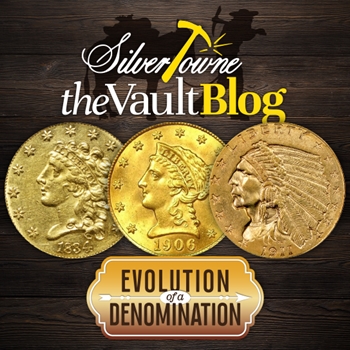
After the Coinage Act of 1834 was passed raising the silver-to-gold weight ratio from 15:1 (1792) to 16:1 and setting the United States Mint’s price for silver at a level below the international market, there were only two gold denominations in current production. With gold coins back in circulation, the half eagle and quarter eagle needed to be recoined which prompted a design change from United States Mint Director Samuel Moore. Chief Engraver, William Kneass, was under a time crunch and thus borrowed John Reich’s large cents design, “Classic Head,” for the quarter eagle.
Classic Head, No Motto on Reverse (1834-1839)
Using Reich’s design, Kneass adapted Liberty facing left with her curly hair coming down the back of her neck and the word “LIBERTY” seen inscribed in her headband. Thirteen stars surround her with the date below. The reverse features an eagle perched on an olive branch with three arrows in its talons. “UNITED STATES OF AMERICA” and “2 ½ D.” are featured all along the outer rim of the design. The motto (E PLURIBUS UNUM) was left off so that the public could distinguish the new, lighter gold pieces.
Modifications to the Classic Head quarter eagle design were made from the very beginning as 1834 issues were struck with two different heads. These would be differentiated by collectors as the “Small Head” and “Booby Head.” By 1835, the coins would depict a taller and thinner bust. Throughout the series, the design would see minor changes every year until 1839 when the quarter eagle would see another design change. The series would see 968,228 business strikes and fewer than 40 Proofs minted. Coins were struck at Philadelphia, Charlotte, Dahlonega, and New Orleans.
Liberty Head (1840-1907)
While the Classic Head design was used after 1834, it was never meant to endure as a suitable symbol on gold coins for a growing nation was always the goal. By 1838, Christian Gobrecht’s design for the quarter eagle would take center stage and start to be used in 1840. A large head of Liberty facing left would be at the center of the denomination, wearing a wide coronet with the word “LIBERTY” inscribed on it. Hair pulled back and held in place by a string of pearls, 13 stars surround her with the date below. While the obverse would change, the reverse would be about the same as it had been since 1808.
Nearly 12 million Liberty Head quarter eagles were produced from 1840-1907 were struck at Philadelphia, Charlotte, Dahlonega, New Orleans, and San Francisco. One coin out of the series is more famous and significant than all the others: 1848 CAL quarter eagle. Made from 230 ounces of California ore shipped east in 1848, over 1,300 quarter eagles were produced and distinguished with the abbreviation CAL. stamped on the die about the eagle’s head on the reverse. Authentic examples have a square period after CAL and are considered by some to be the first commemorative coins struck in the United States.
Indian Head (1908-1929)
With Theodore Roosevelt once again at the forefront of coinage change in the early 1900s, the groundwork was laid for the quarter eagle to get yet another major facelift. The quarter eagle and the half eagle would end up standing apart from all the other coinage because of their design, courtesy of Boston sculptor Bela Lyon Pratt. The obverse features a realistic-looking Indian in a war bonnet. The date, 13 stars, and “LIBERTY” are inscribed along the outer edge of the coin. The reverse shows an eagle perched on fasces and an olive branch with “UNITED STATES OF AMERICA,” “E PLURIBUS UNUM,” “IN GOD WE TRUST,” and “2 ½ DOLLARS” inscribed throughout the design. There was no rim, and the lettering was sunken in a place that is usually flat.
Over 564,000 coins were produced in that first year of 1908, but they were met with mixed feelings as artistic merit and the incused elements were a cause of concern. They were struck through 1915 until the Mint suspended production. They would continue the series in 1925, but it would officially end in 1929 as one of the many victims of the market crash and impending depression.
Source: NGC Coin; The Official 2024 Red Book







